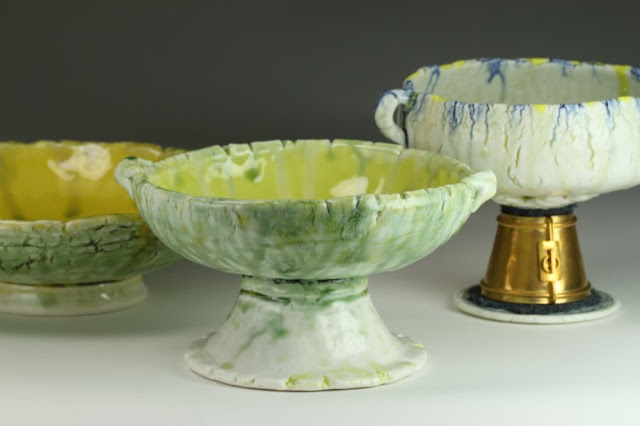It's wonderful to be able to make what you love. Period. It just is. But apparently there are problems too—like the separation anxiety I'm having as I send new pieces off to an exhibition or show, I'm finding it really hard to let go.
Three of the new "Chalice Series" vessels I fired and glazed over New Year are now moving out into two summer shows: "Chalice #2, Just Another Vessel" will be part of the Alberta Craft Council summer exhibition "Shift. A Transformative State Of Mind" which opens July 14 in Edmonton; "Chalice #3" and "Ich Dien (I Serve)" will be available in Calgary at the Ruberto-Ostberg Gallery Show "Connections", opening this Friday June 15. These are handbuilt, labour-intensive pieces: they are slow art, inspired by ancient and ritualistic vessels—though the technology in that ultra-white porcelain, the fabulously stained glazes, and my computer-controlled kiln couldn't be more 21st century. I hope they find new homes because that will mean they have become meaningful to someone else.
We have a long history of needing and cherishing vessels, and I'm very happy to join the procession of potters, extending forward, who will continue to be inspired by the possibilities and provoked by the necessity of containing: food, flowers, ideas, love… Long live the vessel.
I remain mindful of a quote by the art historian and curator Edith Cargill:
“Show me someone who thinks the vessel is dead and right around coffee time I’ll show you a f###### hypocrite!”
P.S. As if by magic, or the Albert Craft Council newsletter, a link to a fabulous exhibition catalogue of ceramics for the table just appeared: "TableSpace" was presented at Alfred University in New York, Fall 2011. The introductory essay offers much to digest about the continued importance of functional ceramic vessels. And lots of really nice pictures. Congratulations to Alberta potter Sam Uhlick who was part of the show.
Three of the new "Chalice Series" vessels I fired and glazed over New Year are now moving out into two summer shows: "Chalice #2, Just Another Vessel" will be part of the Alberta Craft Council summer exhibition "Shift. A Transformative State Of Mind" which opens July 14 in Edmonton; "Chalice #3" and "Ich Dien (I Serve)" will be available in Calgary at the Ruberto-Ostberg Gallery Show "Connections", opening this Friday June 15. These are handbuilt, labour-intensive pieces: they are slow art, inspired by ancient and ritualistic vessels—though the technology in that ultra-white porcelain, the fabulously stained glazes, and my computer-controlled kiln couldn't be more 21st century. I hope they find new homes because that will mean they have become meaningful to someone else.
We have a long history of needing and cherishing vessels, and I'm very happy to join the procession of potters, extending forward, who will continue to be inspired by the possibilities and provoked by the necessity of containing: food, flowers, ideas, love… Long live the vessel.
I remain mindful of a quote by the art historian and curator Edith Cargill:
“Show me someone who thinks the vessel is dead and right around coffee time I’ll show you a f###### hypocrite!”
P.S. As if by magic, or the Albert Craft Council newsletter, a link to a fabulous exhibition catalogue of ceramics for the table just appeared: "TableSpace" was presented at Alfred University in New York, Fall 2011. The introductory essay offers much to digest about the continued importance of functional ceramic vessels. And lots of really nice pictures. Congratulations to Alberta potter Sam Uhlick who was part of the show.

Comments
Post a Comment